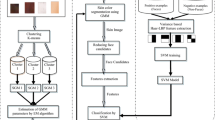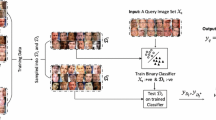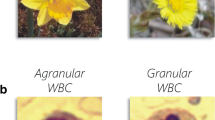Abstract
A novel similarity analysis is presented in this paper for dealing with the problem of mining faces in a complex image background. The proposed approach integrates a robust feature extraction technique based on a specific method of eigenanalysis in the frequency domain of the unique classes identified in the problem at hand, with neural network based classifiers. Such an eigenalysis aims at identifying principal characteristics in the frequency domain of the above mentioned uniquely identified classes. Each unknown image, in the testing phase, is then, analyzed through a sliding window raster scanning procedure to sliding windows identified, through a first stage neural classifier, as belonging to one of the unique classes previously mentioned. After such a sliding window labeling procedure it is reasonable for a second stage neural classifier to be applied to the testing image viewed as a sequence of such labeled sliding windows for obtaining a final decision about whether a face exists within the given test image or not. Although the proposed approach is a hierarchical procedure, its most critical stage is the similarity analysis performed through eigenanalysis in the frequency domain, since, if good identification/ labeling accuracy could be then obtained, it would facilitate final face mining.
Preview
Unable to display preview. Download preview PDF.
Similar content being viewed by others
References
Heisele, B., Ho, P., Wu, J., Poggio, T.: Face recognition: component-based versus global approaches. In: Computer Vision and Image Understanding, vol. 91, pp. 6–21. Academic Press, London (2003)
NATO-ASI workshop, “Face Recognition: From Theory to Applications”, Scotland, UK, June 23-July 4 (1997)
Brunelli, R., Poggio, T.: Face Recognition: Features versus Templates. Technical report TR 9110-04, Istituto per la Ricerca Scientifica e Technologica (October 1992)
Kirby, M., Sirovich, L.: Application of the Karhunen-Loeve procedure for characterization of human faces. IEEE Trans. On Pattern Analysis and Machine Intelligence 12(1), 103–108 (1990)
von der Malsburg, C.: A Face Recognition System Based on the Morlet Wavelet Transform. In: NATO-ASI workshop, Face Recognition: From Theory to Applications, Scotland, UK, June 23-July 4 (1997)
Huang, T.S.: Face and Facial Feature Detection. In: NATO-ASI workshop, “Face Recognition: From Theory to Applications”, Scotland, UK, June 23-July 4 (1997)
Cootes, T.F., Taylor, C.J.: Constrained active appearance models. In: International Conference on Computer Vision, pp. 748–754 (2001)
Fleuret, F., Geman, D.: Coarse-to-fine visual selection. Int. Journal of Computer Vision 41(2), 85–107 (2001)
Rowley, H., Baluja, S., Kanade, T.: Neural network-based face detection. IEEE Transactions on Pattern Analysis and Machine Intelligence 20(1), 23–38 (1998)
Osuna, E., Freund, R., Girosi, F.: Training support vector machines: an application to face detection. In: IEEE Int Conference on Computer Vision and Pattern Recognition, pp. 130–136 (1997)
Rowley, H.A., Baluja, S., Kanade, T.: Human face detection in visual scenes. CMU-CS-95-158R, Carnegie Mellon University (November 1995), http://www.ri.cmu.edu/pubs/pub_926_text.html
Poggio, T., Sung, K.K.: Example-based learning for view-based human face detection. In: Proc. of the ARPA Image Understanding Workshop, pp. II:843–850 (1994), http://citeseer.nj.nec.com/poggio94examplebased.html
Haykin, S.: Neural Networks, A Comprehensive Foundation, 2nd edn. Prentice Hall, Englewood Cliffs (1999)
Author information
Authors and Affiliations
Editor information
Editors and Affiliations
Rights and permissions
Copyright information
© 2009 Springer-Verlag Berlin Heidelberg
About this paper
Cite this paper
Karras, D.A. (2009). On a New Similarity Analysis in Frequency Domain for Mining Faces within a Complex Background. In: Perner, P. (eds) Advances in Data Mining. Applications and Theoretical Aspects. ICDM 2009. Lecture Notes in Computer Science(), vol 5633. Springer, Berlin, Heidelberg. https://doi.org/10.1007/978-3-642-03067-3_24
Download citation
DOI: https://doi.org/10.1007/978-3-642-03067-3_24
Publisher Name: Springer, Berlin, Heidelberg
Print ISBN: 978-3-642-03066-6
Online ISBN: 978-3-642-03067-3
eBook Packages: Computer ScienceComputer Science (R0)




